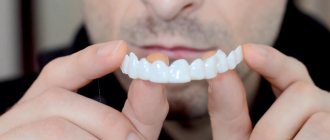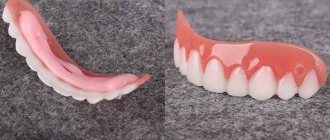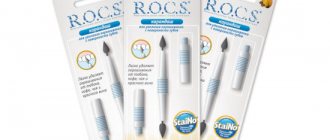Veneers are plates or “onlays” with a thickness of 0.5 to 1.5 mm, which are fixed on the outer surface of the front teeth with special glue. Most often, to install them, minimal processing of the front and visible lateral surfaces of the tooth is carried out, or simply grinding to create a roughness that allows the future structure to attach to the enamel. To determine the choice of suitable plates, it is important to know their features.
Veneers are:
Ceramic (Lumineers, porcelain, IPS Emax glass ceramics, etc.)
Zirconium (zirconium oxide)
BEHIND
Ceramic and zirconium veneers can be installed with minimal or no tooth preparation. For example, lumineers (25-50 thousand rubles per unit) are manufactured in a US laboratory using a unique technology that allows the thickness of the ceramic plate to be made only 0.2-0.3 mm. They are fixed to the tooth without preliminary grinding. This is especially important for people who are afraid of the drill. The advantage of this method is that it is gentle on tooth tissue, and the lumineers themselves have improved aesthetics, creating the effect of a “Hollywood smile.” These “onlays” are not difficult to replace in the future without damaging the tooth tissue.
AGAINST
Since the plates are held only on the visible surfaces of the tooth, then, unlike crowns, it is necessary to create certain conditions for their reliable adhesion. Even with a slight violation of the operating technology, incorrect fixation and their peeling off are possible. Sometimes this results in tooth damage.
BEHIND
Veneers have unique aesthetic properties. They can neutralize age-related changes that are reflected not only on the face, but also on the teeth. Over the years, the color of teeth changes, they wear out, chips, cracks, etc. occur. Installing veneers allows for “dental rejuvenation” similar to cosmetic procedures. A certain form of veneers helps remove facial wrinkles, preserving the youth of the face. The average service life of veneers, depending on the material, is 5-20 years.
AGAINST
Not all veneers can create a long-term anti-aging effect. Composite veneers, unlike ceramic and zirconium veneers, are the most budget-friendly (2-9 thousand rubles). They are created from composite materials, selected by color in the doctor’s office, and not in the laboratory, like ceramic and zirconium structures (15-40 thousand rubles per unit). The result depends on how correctly the doctor can recreate the shape and select the desired color.
Not every specialist is able to achieve a laboratory effect. In addition, one composite restoration can last up to 2-3 hours. It is not difficult to calculate how long you need to sit in a chair to correct the shape and color of the teeth located in the “smile zone”.
In addition, composite veneers deteriorate faster over the years: they gradually begin to shrink and become saturated with dyes from food and drinks. To extend the service life of the “onlays,” it is necessary to correct (grind, polish) the restored teeth once a year or, if necessary, change the entire veneer. Otherwise, in literally 4-5 years they can become completely unusable. The teeth will darken, turn yellow, chips and cracks will appear, and material transitions will become noticeable.
BEHIND
Veneers and lumineers can eliminate unsightly gaps and spaces between teeth, correct the irregular shape of your own teeth, restore congenital and acquired enamel damage (erosion, wedge-shaped defect, etc.), correct the size of teeth, help with mild forms of enamel abrasion, and finally level out stains and darkening on teeth.
AGAINST
It is not recommended to install veneers in case of malocclusion, carious destruction, large loss of tooth tissue, large fillings, absence of chewing teeth and pathological abrasion of enamel and dentin (grade 2 and higher). All this can reduce the degree of fixation of veneers due to the small contact area, and also reduce their strength.
An orthopedic dentist will dissuade you from installing veneers if the patient has bad habits (biting nails, seeds, hard objects, etc.), if he engages in extreme sports (boxing, karate), as well as with bruxism (grinding teeth). nights). If there is a significant change in the color of the enamel (tetracycline, resorcinol-formalin teeth), some types of veneers are contraindicated. Or you should abandon them in favor of crowns, for example, based on zirconium oxide.
Summary
Veneers and lumineers are a real work of art in the hands of a skilled artist when it comes to the correct tactics of orthopedic treatment. In most cases, “onlays” can and even need to be installed on teeth, not only for aesthetic reasons, but also for the purpose of preserving dental health. Indeed, in a vacuum environment under the veneer, the tooth surface is protected from the effects of microbes that cause caries. If you have no contraindications to installing veneers, then feel free to contact a good clinic and see a true master of his craft.
Removable veneers – what are they and how to use them? How justified is such a purchase?
In pursuit of a flawless smile, many are often tempted by the advertising promises of manufacturers of inexpensive removable veneers. In such cases, most often we are talking about budget cosmetic mouthguards made of plastic or sets of template plates, which you need to attach to your teeth yourself using dubious glue from the packaging. Both options have many significant disadvantages. Therefore, in today’s article we will talk in detail about whether it is possible to insert removable veneers yourself and whether they are worth using at all.
Removable veneers - what is this design and what are its features?
What are removable veneers really?
So-called removable veneers have nothing to do with real ones. When describing this method of quick cosmetic smile restoration, it would be inappropriate to ask questions about which doctor places such veneers and whether it hurts to place them at all. The fact is that most often this term refers to cosmetic removable mouth guards, which are put on the entire dentition at once and, in theory, thus transform the smile. In practice, everything is completely different.
Such designs usually have template sizes, so they simply do not fit in most people’s mouths. And even if you manage to capture them, you definitely won’t be able to talk to them normally, much less chew food.
There is another variety - again, template linings for each tooth. Such plastic plates are sold in sets of 70 pieces at a time, with a brush, tweezers and special glue. However, no one knows how safe the composition of this glue is. And such “veneers” are unlikely to look natural and beautiful on the teeth. Therefore, experts in the field of aesthetic dentistry strongly do not recommend the use of such products, since they can not only be useless, but even harmful to the tissues of the oral cavity and the body as a whole.
Where to buy Perfect Smile Veneers
Products purchased here leave no doubt about their quality. To order removable veneers, you need to go to the store’s official website and leave a request. The client pays for the order only upon receipt.
By the way. Most negative reviews after using removable dental veneers are left by users who purchased low-quality plates on third-party sites, for example, on AliExpress. Do not forget that a fake is much inferior in quality to the original product. But most importantly, the products pose a great danger to health, since they contain low-quality and cheap materials that can cause allergic reactions and worsen the health of customers. Original Perfect Smile Veneers have certificates that guarantee the quality of the purchased product.
Perfect Smile Veneers are original hypoallergenic plates that provide customers with a spectacular appearance of their teeth. Safety, ease of use and durability make products increasingly relevant to users.
Elena Malysheva talks about the “Hollywood smile” in the video:
Types of temporary microprostheses, including preparation and creation of impressions
What types of removable veneers are there?
- temporary plates - such plastic overlays are installed by the doctor in the dental office, after preparing and preparing the teeth for the installation of permanent structures. They will need to be worn until permanent ceramic or, for example, zirconium plates are ready. By the way, many people are interested in the question of how old people are to get veneers. So, a similar procedure is performed on patients at least 18 years of age,
- removable template mouthguards and overlays - you can buy them on the Internet, pharmacy or cosmetics store. However, they are really of little use - neither cosmetic mouth guards nor overlays with a cheap adhesive composition will stick to the teeth for a long time and reliably. Moreover, they can damage the enamel and mucous membranes, provoke inflammation,
- individual removable Snap-On Smile - such cosmetic prostheses are made from impressions exclusively in the laboratories of the American company DenMat in the USA or Europe. That is, in a Russian clinic you can undergo all the preparatory procedures, but you will have to wait about a month for the arrival of the finished plates. Such designs, by the way, also allow you to disguise missing teeth. However, experts do not recommend wearing them on a permanent basis - this is an acceptable option as a temporary measure.
Casting method (injection pressing)
With this technology, a wax overlay of the required shape is made onto a plaster tooth model, which is then treated with a glass-ceramic solution and packed into a special fire-resistant mass.
- Under the influence of high temperatures, the wax melts and is burned out in a vacuum.
- The resulting plate is painted in a color that fully matches the color of the enamel and sanded.
This method is simple to implement and allows you to obtain a highly durable prosthesis and an excellent aesthetic effect.
Is it possible to install veneers without damaging the enamel?
If we talk exclusively about removable aesthetic mouthguards, then standard polymers, silicone, polypropylene and other types of plastics of appropriate shades are usually used for their manufacture. All these are inexpensive materials that can be easily processed and painted. Such structures are installed in the oral cavity without any grinding of teeth or taking impressions. However, due to their standardized size, such structures practically do not stay in the oral cavity; it is impossible to speak normally with them, chew food, or even smile.
On a note ! There is a separate type of cosmetic removable dentures Snap-On Smile. They are made individually for each patient, so they require preliminary impressions. The development belongs to the American company DenMat, so the prostheses themselves are created in the laboratory of the manufacturing company. Such onlays stay in the mouth much better and allow you not only to transform the aesthetics of your smile, but also to visually restore missing teeth. However, this option can only be considered as a temporary solution. Read more about Snap-On Smile dentures in our separate article.
However, temporary onlays can also look like real classic ones, that is, one thin plate for each tooth. In dentistry, such products are usually made of plastic and fixed with temporary adhesive until full-fledged microprostheses made of ceramic or, say, zirconium are ready. In this case, preparation and making impressions are an integral stage of smile restoration.
What if you choose subtle options?
Sometimes, when choosing ultra-thin plates, for example, “Lumineers” from the same DenMat company, it is possible to completely avoid turning the living enamel, but here we are talking about full-fledged permanent veneering. On sale you can find cheap template analogues - plastic overlays in a set with glue of dubious quality. Such products cannot be of high quality and, as noted above, it is better to avoid them so as not to harm the enamel and gums
Layer-by-layer method
In this method, plates are made from platinum foil, whose thickness is 0.020-0.025 millimeters.
The foil is pressed around the prepared tooth on a plaster model. The specialist applies ceramic mass to the model and fires it. The foil holds the ceramics during the firing process, which prevents possible distortion and loss of the desired shape. The model is then sanded and finishing touches are made so that the veneer can be seated on the intended tooth without any problems. This technique is economical because it does not require the use of expensive platinum foil. Therefore, manufacturing the structure will not cost a lot of money.
What glue is used to install removable veneers and its features
So-called removable veneers, which look like mouth guards, are simply placed on the teeth. To secure them, no adhesive compounds are needed. Although we cannot talk about any reliable fixation in the case of template cosmetic prostheses. No complicated instructions for their use are required either.
The removable plates, which follow the shape of the teeth and are sold in packs of 70 pieces, have a template shape. They are attached using a special glue that comes in each set. The kit usually also includes a special brush and tweezers. But if professional dentistry uses proven compounds, then in this case it is not entirely clear what exactly the composition of the glue is and how safe it is for the body. Therefore, dental experts strongly recommend not to risk your health.
Classic non-removable products are fixed with a special heavy-duty adhesive; subsequently, you will not be able to remove them yourself. But for Cerinate (DenMat) lumineers they use a special patented adhesive composition, which additionally has protective properties for the enamel[1].
The price of the prosthesis depends on the material chosen for the veneer
And, of course, on the doctor’s qualifications. When making veneers, composite or ceramic is used. I recommend placement of ceramic elements to my patients.
Composite linings have the same strength properties as ceramic ones. The main disadvantage of overlays is the rapid and irreversible change in color when drinking coloring drinks: natural cherry juice, coffee, and so on. The wearing period of composite veneers is limited, a maximum of five years. Veneers are inexpensive, the price of one unit is 8-9 thousand/rub. Therefore, patients with any income can order them.
Preference for ceramic products is dictated by their complete external correspondence with natural teeth.
Throughout their entire service life, and wearing ceramic veneers for about 25 years, they do not lose their original whiteness.
The only drawback is the cost of the ceramic lining.
Fixed plates - indications and installation
But let’s return to the question of what veneers and lumineers are in the classical sense. We are talking about very thin overlays that are fixed on the front side of the front teeth in order to hide their aesthetic defects, that is, to correct the shape and size of incisors and fangs, to disguise too large gaps between the teeth, to give the enamel a beautiful snow-white shade and vibrant shine. After such a procedure, your smile can be transformed beyond recognition.
In their classic form, veneers are immediately recognizable
The plates themselves are made from durable and aesthetic materials, most often from pressed ceramics or zirconium dioxide. There is also the option of more budget-friendly composite plates. By the way, with the help of a composite, teeth are literally grown in a direct way - the front surface of the incisors is covered with a photopolymer and immediately illuminated with a polymerization lamp, that is, all manipulations are carried out directly in the patient’s oral cavity.
If we talk specifically about the indirect method, then the thickness of one such structure usually varies from 0.6 to 0.8 mm. Therefore, before installing microprostheses, the doctor first grinds off a small layer of enamel in order to preserve the anatomical parameters and aesthetics. Each plate has a small protrusion at the base, which, after fixing the product, neatly overlaps the cutting edge, which increases its strength and improves other performance characteristics.
“When I was getting veneers, I agreed to have them trimmed myself, but honestly, I didn’t think that so much would be removed! I almost cried when I saw my smile after the dissection. Thank God they gave me removable plastic pads, otherwise I don’t know how I would have walked. With plastic ones, of course, it’s not very convenient, but what can you do? Now I’m waiting for my ready-made teeth to arrive from the States.”
Vikki, review from the women's forum woman.ru
But there is another option - ultra-thin plates with a thickness of 0.2-0.3 mm. The most popular brand that produces these types of pads is the Lumineers brand, which belongs to the DenMat company. To create ultra-thin plates, they use a special patented material called Cerinate, which is both highly durable and almost flawless in aesthetics. In some cases, when choosing ultra-thin onlays, it is possible to completely avoid grinding your living enamel.
Fixed plates are installed in patients using approximately the same algorithm. The universal sequence of actions is briefly described below:
Although turning the enamel is not always necessary, it is still one of the stages of action
- preparation, including treatment of carious cavities, replacement of old fillings, anti-inflammatory therapy if necessary, removal of plaque and deposits, selection of the shade of future restoration using the Vita scale,
- turning the enamel - removing a small layer of living hard tissue so that after installing the plates, the teeth do not look too voluminous and massive,
- making impressions or 3D scanning of the internal structures of the oral cavity,
- conducting photometry – fixing photoparameters of facial symmetry,
- bite modeling on an articulator or using advanced digital smile design software,
- installation of temporary plastic overlays to protect ground incisors and canines and temporarily hide aesthetic defects.
Once the permanent products are ready, it is time to remove the temporary overlays. Finished permanent veneers are attached using a special heavy-duty adhesive composition.
Classic non-removable plates are the best option if you want to get a highly aesthetic and durable result. Any removable structures aimed at aesthetics are acceptable only as a temporary measure, and many of them are not suitable for use at all, being only a product of an advertising gimmick.
Price
The cost of dental veneers is not high compared to other methods of dental restoration and depends on the method used to make the onlay.
- With the direct manufacturing method, veneers will cost less than those made in the laboratory.
- Larger sizes are more expensive than smaller ones due to the larger amount of work involved.
- If you install more than two overlays at the same time, the cost will be lower than if you install one plate at a time.
- For minor tooth defects, the cost of restoration will not be so high.
The final cost includes:
- Dentist consultation.
- Dental treatment.
- Oral hygiene.
- Tooth preparation.
- Anesthesia.
- Computer modelling.
Not the least influence on price formation is the status of the dental clinic, the experience and qualifications of the doctor.
| Dental veneers | Prices (in rubles) |
| Composite veneer | From 3000 |
| Porcelain veneer | From 15000 |
| Zirconium based veneer | From 17000 |
How many teeth can veneers be placed on?
When answering the question of how veneers are placed, you should immediately pay attention to the fact that this kind of restoration plates are fixed only on the front teeth on their front side. By the way, such onlays are also placed on crooked teeth, but only when they have slight curvature. Usually they are recommended to be attached to all incisors and canines that fall within the smile zone, and these are 10 front upper and 8 front lower teeth. Veneers are placed using a special technology, so only an experienced specialist can install them correctly. The use of this restoration method allows you to make a Hollywood-style smile snow-white and irresistible.
Your future smile is worth all the effort
When to install
Teeth restoration with veneers is performed in the following cases:
Photo: Defects of anterior teeth
- In the presence of a congenital defect of tooth enamel.
- If the color of the tooth has changed after root canal treatment, or if there are old fillings.
- For enamel defects caused by chips, cracks, demineralization, erosion.
- In the case of fluorosis, which occurs when there is an excess of fluoride.
- If there are large gaps between the teeth.
- In case of irregular shape and position of the tooth, as well as violation of its integrity.
As well as other cosmetic defects of teeth are indications for the installation of veneers.










